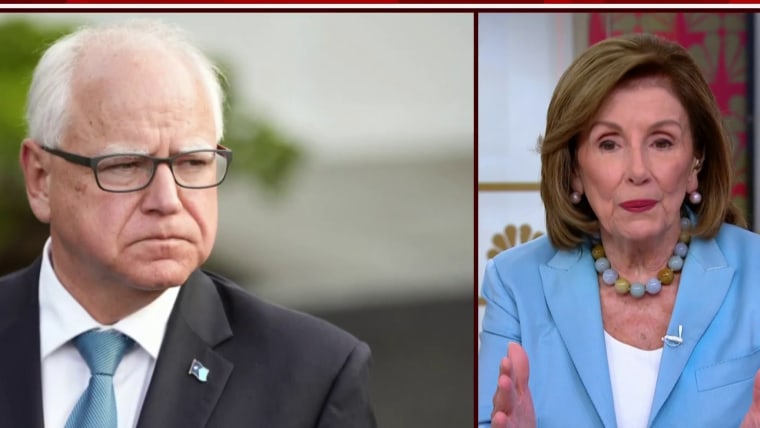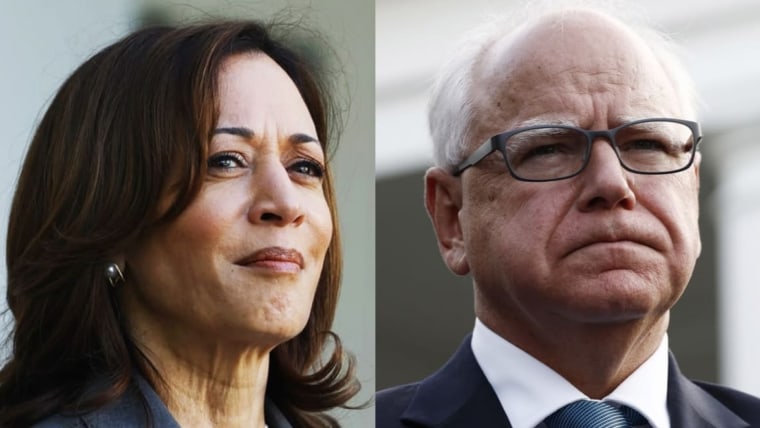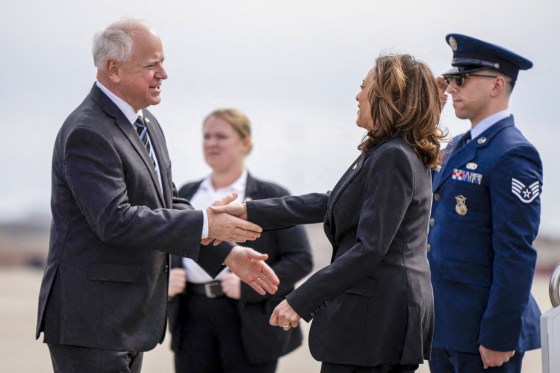Vice President Kamala Harris just made her most important decision as a presidential candidate so far: the selection of Minnesota Gov. Tim Walz as her running mate. The choice gave the electorate its first glimpse of her judgment on the most important matters.
Typically, presidential candidates pick running mates who address a weakness or build a bridge to the wing of their party alienated by their nomination.
In 1952, Dwight Eisenhower selected Richard Nixon, then seen as a pugnacious conservative, after he beat the right’s hero — Ohio Sen. Robert Taft — for the Republican nomination. In 1960, Sen. John F. Kennedy, from Massachusetts, chose Senate Majority Leader Lyndon Johnson, from Texas, to give his ticket geographic balance.
Outsider nominees looked for something else beyond D.C. connections and governing experience when trying to balance their tickets: foreign policy credentials.
In 1968, Nixon settled on little-known Maryland Gov. Spiro Agnew, because he was not objectionable to either the liberal or the conservative wing of his party. One Nixon aide remarked that if they had programmed a computer to produce a “Vice President who would do least harm to party unity,” it would have selected Agnew.
Many more prominent possibilities would have enraged one wing of the GOP or the other. As a sign of how much more rudimentary (or nonexistent) vice presidential vetting was in the pre-Watergate era, Agnew would later resign in disgrace over kickbacks he had taken as governor.
As voters started to warm to outsider candidates — usually governors with zero ties to Washington — vice presidential nominees became a way to build bridges to the political establishment and add an adviser with Washington experience. That was the case when former Georgia Gov. Jimmy Carter selected Minnesota Sen. Walter Mondale (who also provided geographic balance) to join his ticket in 1976.
In 1980, after negotiations to put former President Gerald Ford on his ticket failed at the last minute, former California Gov. Ronald Reagan buried the hatchet and selected his strongest primary opponent, George H.W. Bush. The choice was an olive branch to the moderate wing of the party, which had serious concerns about Reagan. Eight years later, Bush did the inverse. Conservatives had long harbored doubts that he wasn’t really one of them, so he went with the boldest choice on his short list and selected Indiana Sen. Dan Quayle, a young conservative up and comer, as his No. 2.

Then-Arkansas Gov. Bill Clinton discarded the common formula in 1992 when he selected Tennessee Sen. Al Gore, a fellow Southern moderate, as his ticket mate. But the 46-year-old Clinton was running on generational change against the 68-year-old Bush. And the 44-year-old Gore fit with this theme.
Eight years later, Gore also discarded the standard playbook for selecting a running mate in the hopes of distancing himself from Clinton’s personal scandals. He chose the devout Connecticut Sen. Joe Lieberman — the first Jewish vice presidential nominee. The senator had been the first Democrat on the national stage to condemn Clinton for his peccadilloes. Gore anticipated that Lieberman’s rectitude would help appeal to voters who liked Clinton’s governance and policies, but cringed at his personal behavior, as well as blunt Republican attacks over Clinton’s character.
There is one unmistakable pattern in the history: the worst vice presidential selections have the biggest impact.
Outsider nominees looked for something else beyond D.C. connections and governing experience when trying to balance their tickets: foreign policy credentials. That was a main reason George W. Bush selected former Defense Secretary Dick Cheney to be Lieberman’s opposite in 2000. Similarly, Barack Obama, who had only spent four years in the Senate, chose Senate Foreign Relations Committee Chairman Joe Biden to run with him in 2008.
There is one unmistakable pattern in the history: the worst vice presidential selections have the biggest impact. There are three glaring examples.
First, third-party candidate George Wallace selected retired Gen. Curtis LeMay to be his running mate in 1968. Among LeMay’s blunders: ignoring the counsel of Wallace’s staff not to discuss nuclear weapons at his introductory press conference. Instead, he declared that Americans had a “phobia” about using them even though “there are many times when it would be most efficient to use nuclear weapons.” A few weeks later, LeMay told an audience, “There are many cases when abortion is proper.” The question, according to the general, should be left up to “the people concerned and the physicians.” He simply had no political judgment. The abortion position alienated blue-collar Northern Catholics who were essential to Wallace’s bid.
The LeMay disaster was one of the main reasons that Wallace’s support dropped off significantly in the final weeks of the campaign.

Four years later, South Dakota Sen. George McGovern captured the Democratic nomination by taking advantage of a new selection process that placed much greater emphasis on primaries. Yet he was an insurgent, and he didn’t have the nomination locked down until the delegates to the Democratic National Convention reversed a decision by the Credentials Committee that had stripped McGovern of some of California’s delegates. With McGovern’s staff preoccupied with the intraparty battle, they didn’t focus on choosing a running mate until the last minute.
The McGovern camp, especially the candidate himself, assumed that he could eventually prevail upon his top choice — Massachusetts Sen. Ted Kennedy — to accept the vice presidential slot. When that proved impossible, McGovern’s staff undertook a chaotic and haphazard process with an impending deadline. After several other preferred choices declined offers to join McGovern’s ticket, and Kennedy demurred again, the South Dakotan selected Missouri Sen. Thomas Eagleton with fairly minimal vetting. That decision erupted on McGovern when it came out that Eagleton had received shock therapy for depression on multiple occasions in the 1960s. Eighteen days after McGovern selected Eagleton, he was forced to withdraw from the ticket.
Typically, presidential candidates pick running mates who address a weakness or build a bridge to the wing of their party alienated by their nomination.
In 2008, Arizona Sen. John McCain needed a bold move to reset the trajectory of the campaign. He rolled the dice on little-known Alaska Gov. Sarah Palin — the first female ever on the Republican ticket. In some ways, the selection worked brilliantly: Palin became a conservative rock star, enthusing the GOP base, which was ambivalent — or worse — about McCain. But Palin’s lack of knowledge of world affairs and clear lack of capacity to run the country did damage, in large part because McCain was 72 years old, at the time considered old for the presidency.
The elder Bush’s choice of Quayle in 1988 wasn’t a blunder on quite the same level. Yet the rollout of his selection was exceedingly rocky, in part due to questions over whether Quayle’s wealthy family used connections to get the senator into the National Guard during the Vietnam War. He also produced one of the more infamous debate moments in history, and his weakness prompted future President George W. Bush to counsel his father to dump Quayle from the ticket in 1992 in favor of his defense secretary: Dick Cheney. The senior Bush didn’t take that advice and lost to Clinton.
What does all of this mean for Harris? The next three months will tell us whether her staff properly vetted Walz, whether choosing him was advantageous politically, or whether she made a blunder for the ages. We’ll find out soon enough.
